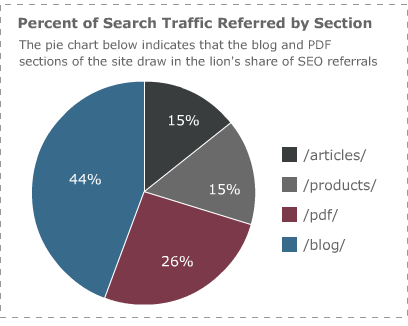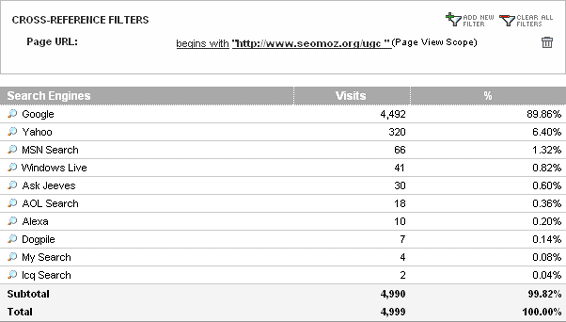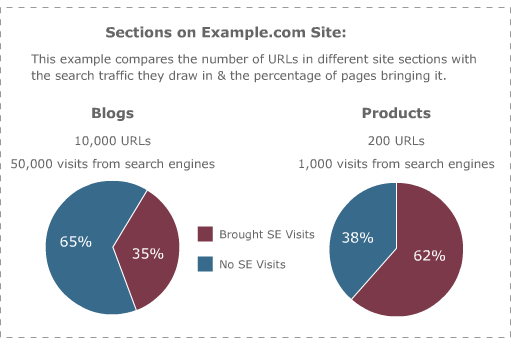
Benchmarking Your Website: Metrics to Review Before an SEO Engagement Begins
Many SEO projects begin with a site review or audit, identifying potential weaknesses and opportunities. However, a great number of these analyses leave out a healthy dose of collecting metrics - a critical factor in helping to benchmark future progress and see how far you've come (and what effect your SEO changes have had). Thus, I figured it would be valuable to review, in full, the pre-review puzzle pieces essential to beginning an SEO campaign or overhaul.
Identifying the Site Development Process & Players
Before we begin on the metrics and site analysis itself, it's wise to consider - shock, shock - the people! Although it may seem like websites spring from the ether of servers and code, human beings are in fact behind every piece of content, page, file and domain name on the web. Figuring out the responsibilities and duties of the people on the web development team is an essential part of the auditing & review process for every consultant or in-house SEO seeking to implement change.
If you're a small business or an individually run site, you can skip this section. For those of you that have an internal organizational hierarchy, here's the process I like to follow:
- Step 1: Identify the website management:
- Who manages the front-end design & production?
- Who handles back-end development and databases?
- Who is responsible for content approval?
- Step 2: Where is approval required?
- Which pages need approval from who in order to make changes?
- What permission is required to make sitewide changes or add new pages/navigation/content?
- Step 3: Who has access to website reporting data?
- What programs track visitor activity on the site?
- What are the logins to the visitor tracking software?
- Is log-file access or spider monitoring available?
Next, you'll need to consider the site's content management system and flexibility. SEO upgrades often require changes outside the scope of a typical CMS, and knowing this early on will give you the foresight required to prepare and accurately estimate the resources you'll need to allocate to the project. Ideally, you should create and maintain a document that tracks the areas above and records the responsible parties and login information. Once you start making recommendations, this will considerably speed up the development process.
Categorizing and Segmenting Your Site
In order to conduct an accurate analysis of your search engine traffic, you need to have a good idea of not only how much search traffic you're pulling in, but which sections of content are driving value. Very frequently, more link-worthy and well-linked-to content like blogs, articles and top level pages overperform while other sections languish in obscurity. By effectively segmenting your site into similar groups you can uncover the discrepancies.

My personal methodology for this is to segment search traffic in the web analytics program by restricting to URL matches. Simply view the list of pages receiving search traffic, then filter by URL - you can use either the "contains" or "begins with" settings to help narrow down to the section(s) of interest.

In the example above, you can see only those pages in YOUmoz that brought in search traffic. This same methodology can be applied to all the other areas of SEOmoz, helping tell us which parts of the site are bringing in traffic from the search engines. Once you have this data, it's time to make some determinations about size and proportions - basically, you need to know how many search accessible pages are in each section and what percentage of those are bringing in traffic. Otherwise, you might be severely miscalculating value and opportunity.

Take the example of a site with 10,000 blog posts and 200 product pages. The blog posts are bringing in 50,000 search visits per month while the product pages send 1,000 search visits per month. While this might seem like a fair balance (both are bringing in an average of 5 visits per page), it's not enough data. We need to know what percent of pages in each section are sending any traffic at all, and preferably look at the distribution of visits to pages. If only 1,000 of the 10,000 blog posts are sending 95% of those 50,000 search visits, we can quickly make the assumption that there's a problem and investigate (typically, if that were the case, I'd be thinking poor archiving with lots of ugly pagination is responsible, but it's always worth a look).
In any analytics assessment, you have to dig deep to find the answers and SEO is no different. Get the right numbers in the right way and you can accurately monitor what's going on; make assumptions based on incomplete or surface-level data and risk squandering potential opportunities.
Assessing Historical Progress
As you collect metrics for the SEO process ahead, it's extremely valuable to get historical as well as current data. My preference is too look at no fewer than 6 months, and preferably 2 years of data on all of the following points:
- Quantity of content - how many pages have existed on the site?
HINT: Look at the number of pages listed in the "most popular pages by URL" section - Search engine inclusion - what percent of these have drawn in search traffic?
HINT: Refine the list from above by only pages receiving search traffic and see what numbers come up - Link acquisition - what has been the rate of growth for links?
HINT: Use referring URLs over time - the data from the engines won't be particularly helpful here unless you've been manually keeping track of it (or using something like SEO Analytics). - Overall search traffic - how much has it gone up/down in the past?
HINT: This one's easy, just look at search engine traffic over time - Distribution of search traffic across engines - has Google shrunk while Yahoo! rose?
HINT: Another easy one to solve; simply separate the engines individually
Once you have this information, you can apply it immediately by identifying spikes and drops. What were the events that preceded both positive and negative changes to the site's SEO? You'll want to repeat projects that brought value and ditch those that weren't worth the time and energy. Particularly when it comes to public relations, press/media campaigns and viral content, watching these numbers can give you a real sense for performance and ROI.
Leveraging Data for SEO Improvements
Once you've assembled the data you need, you're ready to begin an SEO evaluation and get to work improving your site's ability to perform in the engines. The process of data collection itself is valuable - you'll know how to assess performance for the future (and you've got a baseline from which to compare), but that's not the only benefit. The information you collect should allow you to be smarter about the methods you pursue for search engine optimization. For example, discovering that only 20% of the pages on your site bring in search traffic can be an instant alert that accessibility, duplicate/thin content or lack of link juice are responsible for keeping a high number of URLs out of the indices. Likewise, many pages targeting high value keywords but pulling in minimal search referrals can indicate that better optimization and possibly more/better links are required to rank competitively.
Please do share your thoughts around benchmarking metrics for SEO and how to apply them in campaigns.
The author's views are entirely their own (excluding the unlikely event of hypnosis) and may not always reflect the views of Moz.



Comments
Please keep your comments TAGFEE by following the community etiquette
Comments are closed. Got a burning question? Head to our Q&A section to start a new conversation.